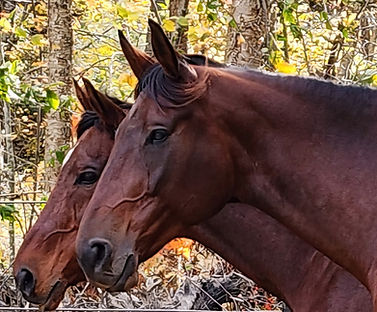Above the bit, behind the bit, on the bit
- Laura Claman
- May 8, 2019
- 3 min read
Above the Bit, Behind the Bit, On the Bit
The best way to get a horse on the bit is to focus on the horse’s body. What is on the bit? Being on the bit is what happens when the horse is moving forward and straight and accepts the connection from your arms/hands. Accepting your hands means that your horse trusts that your hands will be consistent and kind whether in walk, halt, trot, jumping, reinback and any situation so long as you are on the horse’s back. Above the bit occurs when the horse is resisting the rider's hands by moving away from them upwards. Being behind the bit occurs when the horse is resisting the rider's hands by moving behind the connection. In both cases, the problem is communication that results in loss of connection and balance. For more about hand aids, refer to my earlier post on this topic.
Many riders are focused on getting a horse in a “frame”. Unfortunately, the belief is that when the horse’s crest is round and the head is down, the horse is on the bit. This is a false frame. I can have you look at photos, but I don’t want to try to place the horse’s head into a position. Let’s take the head and neck out of the equation for a moment.
Riding is a process where a bipedal human is seeking to move as one with a quadruped equine. Riders must be able to balance their bodies on the horse through any movement of the horse and not interfere with the natural way of going for the horse. The horse has no problem moving without the rider (barring any physical ailments). The rider gets on and now the horse is asked to move in the speed and direction the rider wishes. Further, rider and horse (hopefully) create a language to understand where to move and how fast to get there in balance. The natural reaction for a human is to “hold on” for balance. This reaction has to be eradicated. It’s one reason why learning to ride is a long process.
An effective rider shifts the horse’s balance off the forehand and towards the hind end. This doesn’t happen by pulling on the mouth. It happens with lateral and longitudinal exercises to strengthen the muscles in order to carry more weight towards the hind legs. Transitioning from gait to gait or within a gait (longitudinal movement) jumping, shoulder-in, haunches in, leg yield, half-pass (lateral movement) when the rider focuses on the fluidity and flexibility of the movement changes the balance to be more even or uphill. Now the horse will trust that no matter what type of movement the horse does, the rider’s hands will be consistent and kind. Misunderstandings occur when the rider is unaware of moments when their body hinders what they think they are asking the horse to do. My job as a trainer is to point those moments out to the rider. When they realize their aids were conflicting, it’s obvious why the horse was confused. Some of these include crossing the hands over the horse’s withers, spreading the hands out very wide, leaning in a turn or during lateral work, pinching the knees, locking muscles and the big one – not breathing.
So to get your horse to get “on the bit”, concentrate on the horse’s way of moving and balance. Moving on the bit is a result of correct balance and movement of both horse and rider. Placing the horse’s head into a position with sea-sawing, hands at the knees or leather straps of any sort is harming the balance and movement. Be patient yet exacting. Praise and be supportive. Most of all, enjoy these upcoming lovely riding days with your friend and partner.



Comments